The Acklin Women
By: Nina Bagley
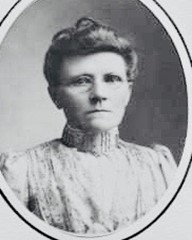
Mrs. Helen Goodsell Acklin
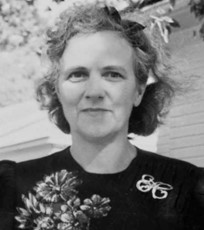
Ethel Acklin Calvert, circa 1929
Breezing through my 1900s Gleanings in Bee Culture Magazines, I found a beekeeping woman and her daughter who caught my interest: Mrs. Helen Goodsell Acklin and her daughter Miss Ethel Acklin from St. Paul, Minnesota. Ethel would marry Howard Root Calvert, son of Maude Root Calvert, who was the daughter of A. I. Root.
Helen Goodsell was born in New York on May 3, 1857. Her parents, Jessie and Laura Goodsell, were both born in New York. Helen was the youngest of five children. Her parents moved to Wisconsin when she was very young. She attended a country school and then a village school, preparing her for a career in teaching. Her passion for honey bees started at a young age. In her teens, she told herself that she would have bees someday, but it would be a while before this happened.
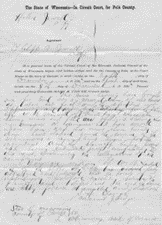
Helen’s Divorce Paper, Dec. 8, 1885
At fifteen, Helen married her first husband, Phillip P. Jewell on November 11, 1872. He was ten years older than Helen. I couldn’t find much information about Phillip other than he was in the Civil War and that Helen served him divorce papers. In 1885 you needed proof and a reason for getting divorced. The grounds for divorce were adultery, desertion and abuse. The ink had faded on her divorce papers and was hard to make out. I’m sure she had her reasons- the Civil War was brutal and many men suffered long term mental and physical illnesses from serving in it.
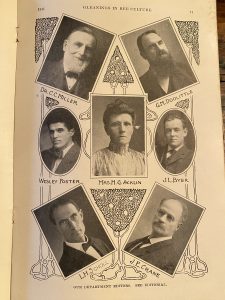 Phillip P. Jewell didn’t show up for court. Helen was granted her divorce on December 8, 1885 at the State of Wisconsin Circuit Court for Polk County. While living in St. Paul, Minnesota, in 1884, she met her second husband. James C. Acklin, who was working as a contractor. He had been married before and had a daughter, Annie. The two married on December 8, 1885. The same day Helen was granted her divorce. She was 28 years old. What a courageous young woman! Talk about killing two birds with one stone.
Phillip P. Jewell didn’t show up for court. Helen was granted her divorce on December 8, 1885 at the State of Wisconsin Circuit Court for Polk County. While living in St. Paul, Minnesota, in 1884, she met her second husband. James C. Acklin, who was working as a contractor. He had been married before and had a daughter, Annie. The two married on December 8, 1885. The same day Helen was granted her divorce. She was 28 years old. What a courageous young woman! Talk about killing two birds with one stone.
James C. Acklin was born in Pennsylvania in 1857. He was a contractor and builder, and was a prosperous man. A. I. Root described him as dignified, gentlemanly, quiet and significantly large in stature. The time for bees finally came for Helen shortly after they were married. Fortunately, some bees were on the lot where they were building a home and thus began their beekeeping journey. For a present to his wife, Mr. Acklin, made her seventeen colonies of American hives. The bees were not the most friendly, so they replaced them with a gentler stock. The frames were all glued together and made a mess out of the hives. It took some doing to pull them apart.
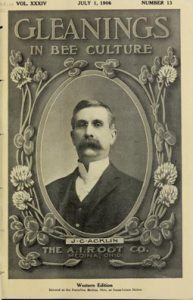
J.C Acklin
July 1, 1906 The Western Edition
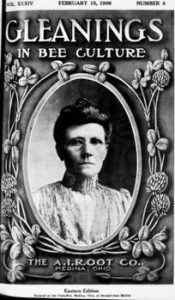
Helen G. Acklin
Gleanings Eastern edition February 15,1906
Nevertheless, Mr. Acklin meant well, and Mrs. Acklin transferred them to Langstroth hives with the assistance of her husband. In 1890, they went west to California, but in the Fall of 1891, they returned to St. Paul, where they planned on building a life together. Their daughter Ethel was born in the Winter of 1892. And the following Spring, 1893, they began handling beekeeping supplies. Very little building was going on during the hard times, and Mr. Acklin secured a position as a lumber inspector with the Great Northern Railway. He worked for several years. Both of them tried their best to prevail. Mrs. Acklin kept a watchful eye on their daughter and ran the bee supply business. Like any good business, with a vision and hard work, it will grow over time, and this is what happened. The work became overwhelming! Her husband effectively resigned from his position with the railroad to help his wife out full-time with the bee supply business. He devoted his time to his family and the business of bees. Mr. and Mrs. Acklin both were active in the Minnesota Beekeepers Association. They both were closely associated with helping each other and working side by side until Mr. Acklin’s sudden death in 1906.
After the death of her husband, Mrs. Acklin continued with beekeeping, having her ups and downs working her bees. She had over 100 hives and several out-apiaries. Even then, disaster sometimes comes knocking on one’s door. One morning she realized water overflowed the cellar apiary, and sand was running into the entrances and drowning the bees. I’m sure if you kept bees long enough, you would have had issues with your bees. But can you imagine the cellar filling up with water? The colonies floated around like fishing bobbers until rescued by men with rubber boots and a long pole!
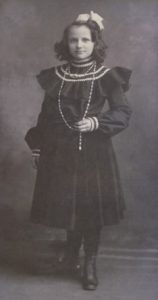
Ethel Helen Acklin, 13
1913
A woman with less love for the honey bee and less perseverance would have surrendered in despair, and to add to it, she felt alone. But Mrs. Acklin kept on, learning something by hard knocks, and from experience and her bee books, she followed Doolittle’s method of raising queens. It would be discouraging and make one choose another occupation, but with her guiding principles, she prevailed. With her small beginnings, Mrs. Acklin was one of the most successful beekeepers in St. Paul, Minnesota. And she was well known in Wisconsin too. Running a sizeable queen-rearing apiary at her home, she was a prominent dealer in beekeeping supplies for over fifteen years, alongside being an attentive mother.
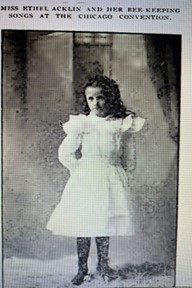
“MISS ETHEL ACKLIN AND HER BEE-KEEPING SONGS AT THE CHICAGO CONVENTION.”
Her daughter Ethel knew more about bees than most young women and men. She accompanied her mother and father to the bee conventions. Ethel remembers in 1900 when she was nine, singing solo and chorus songs, the music by Dr. C.C Miller, during the National Convention in Chicago. How she enjoyed the time with her parents. The death of her father was not easy on both mother and daughter.
Mrs. Acklin continued her business for a few more years, but her failing health made her make a change of her occupation and climate. So she moved back to California in 1908, eighteen years since she had last been there. She didn’t entirely give up on bees. At fifty-one, Mrs. Acklin, with her daughter, bought a home in Glendora, California, and purchased an orange grove twenty-five miles outside of Los Angeles. She became a rancher and an orange grocer keeping a few hives.
She also attended the bee conventions. She edited the Beekeeping in Southern California department in Gleanings. Mrs. Acklin was against beekeepers that sold adulterated honey and worked aggressively to put them out of business! She wrote in Gleanings in Bee Culture: “I wonder how many beekeepers know that honey adulteration is happening right in our midst; if beekeepers work together, these swindlers can be put out of business. Whether it be the small grocer who puts just a little glucose in the honey to keep it liquid or the wholesale man who mixes tons, the effect is the same. People soon take a dislike to glucose honey. They stop eating honey altogether. So beekeepers lose money on two counts, less honey being consumed while the output increases. How can this adulteration be stopped? All beekeeper’s associations in our State, whether county clubs, district unions or State organizations, should unite under one banner in fighting this evil, and send a large and enthusiastic delegation, composed of delegates from each society, to the legislature this Winter to represent the beekeeping industry of our State.” Gleanings, 1910 (pg. 749).
When A. I. Root Co. established a branch office in San Francisco, Mrs. Acklin was given charge of it and continued to work until her death on May 30, 1915. A. I. Root enjoyed visiting Mrs. Acklin’s home in Oakland when he was on business in California. And found her to be commendable, a good businesswoman and a loving mother.
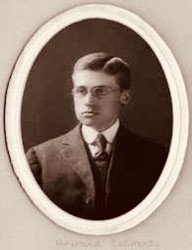
Howard Root Calvert
1923
A. I. Root’s grandson Howard Root Calvert took care of the A. I. Root Company’s exhibit booths at the San Francisco expositions. And it was during one of these visits Howard would meet Miss Ethel Acklin. They announced their engagement to be married. Ethel’s mother passed away a few months before the wedding. The two were married on Tuesday, July 6, 1915, at the home of the groom’s parents, Mr. and Mrs. J. T. Calvert, in Medina, Ohio. Ethel was grieving her mother, her last surviving relative, and is said to have held up bravely. The death of the bride’s mother made it necessary for Ethel to be married in Medina, Ohio.
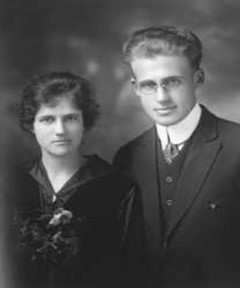
Mr. and Mrs. Howard Root Calvert
Immediately following the ceremony, the couple drove to Elyria, Ohio where they started their long trip back to California. Mr. and Mrs. Calvert were both in charge of the San Francisco office, taking hold where Ethel’s mother left off. Mr. and Mrs. Calvert dealt with life’s realities and an active bee business. Ethel was said to have been “the bee man” of the establishment. In 1916, Mr. and Mrs. Calvert returned to live in Medina, Ohio, where they would start their family. Howard continued working for his family’s business, the A. I. Root Company.
The family had ultimate happiness and then ultimate loss. Mrs. Calvert’s husband died suddenly as a young father at thirty-two in a tragic plane crash while giving lessons on June 27, 1924, in Akron, Ohio. He was not flying the plane but the student, Mrs. Whichershelm, was. What a tragedy! Now widowed at a young age, Ethel had three young daughters to think about. Rebecca, seven; Roberta, five; and Ruth, four. Her daughters were all she had left, falling back on her husband Howard’s strength, her mother’s tenacity, and her own will and faith, Ethel would return to California and overcome by providing for her girls, owning her own home and bee supplies company just like her mother had done.
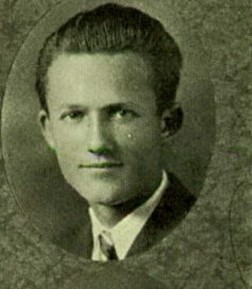
Alfred Francis Nippell yearbook picture
It would be thirty-six years before Ethel would remarry. But I always say, “there’s a lid for every pot.” In 1960, she married Mr. Alfred Francis Nippell. He was fifty years old, his occupation was a bookkeeper, and he had never been married; Ethel was sixty-seven. They were married for twenty-eight years. Ethel slowed down regarding the bees, just keeping some bees in the country. Ethel was ninety-five when she passed away with her family by her side on January 8, 1988.
She shared the love of the honey bee. Endured the loss of her parents and her husband at a young age. She raised three daughters who were related to the Root family. She had four grandchildren and eleven great-grandchildren, which gave her much joy. Her second husband Alfred provided her with love, companionship and security. He passed away at the age of ninety in 2000 in San Diego, California. Mother and daughter both having parallel lives. “I admired their tenacity, entrepreneurship and strength; the busy bee has no time for sorrow.” —William Blake
Nina Bagley
Ohio Queen Bee
Columbus, Ohio








